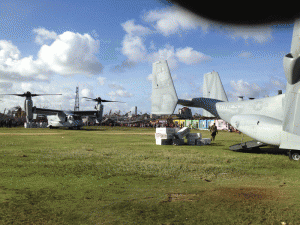The Osprey and HADR Missions in the Pacific: The Indonesian Opportunity
As the Osprey gained operational experience in the Pacific, it became a frequent enabler for US assistance in Humanitarian Assistance and Disaster Relief missions. As Brigadier General “Stick” Rudder, then the Commander of the USMC 1st Marine Air Wing put it in a 2014 Stars and Stripes article:
Simply put, the Osprey can respond faster and farther to any situation where we might be called, including our most frequent mission — humanitarian assistance and disaster response. The Osprey is the ideal aircraft to respond to a disaster or any remote area because it can go so far and fast, carry a great deal of supplies or personnel, and it does not need a runway to land.
In fact, during Operation Damayan, Ospreys flew about the same distance — 1,118 miles — to the Philippines in three hours. The Ospreys evacuated 1,200 people and delivered more than 20 tons of supplies to remote areas where neither traditional airplanes nor helicopters could reach. That gives you an idea of the tremendous capability the Osprey brings.
Now Rudder is Lt. General Rudder, the USMC’s CG in the Pacific as head of MARFORPAC with the Japanese now enhancing the Osprey presence in the region with their own acquisition of V-22s and the possible addition of the Indonesians to the Osprey Nation.
In interviews we conducted in 2013, we talked with the Osprey squadron which came to the Philippines as part of the effort to support relief efforts in the Philippines in the wake of Typhoon Haiyan.
VMM-262, the “Flying Tigers, functioned as the lead presence force to assist in standing up relief efforts in the immediate wake of Typhoon Haiyan.
Having integrated capability for the point of the spear is crucial and the Osprey clearly functioned as the tip of the tip of the spear for rapid insertion in this HADR operation.
As one senior Marine put it:
1st MAW had Ospreys and Hercs in Tacloban about 72 hrs after the storm passed.
And I am not talking just about people on the ground but real, self-sustaining capability to move the mountains of relief supplies to where it was needed and where nothing else could get the job done so effectively.
There is no question it is a just a small effort against an immense catastrophe but the combination of rapid deployment and true capability is a crucial part of getting the response in play.
The “Flying Tigers” squadron formerly flew CH-46E Sea Knight helicopters. The Osprey transition for the squadron was the squadron’s fourth redesignation since its activation in 1951. It has supported operations in Lebanon, the Dominican Republic and Vietnam from its duty station at Marine Corps Air Station Cherry Point, N.C. It relocated to MCAS Futenma in 1992, going on to participate in humanitarian assistance and disaster relief efforts in Indonesia, the Republic of the Philippines and Japan.
At the ceremony for the Osprey transition for the Flying Tigers, Col. Brian W. Cavanaugh, the MAG-36 commanding officer noted: “For more than 60 years, 262 has earned many honors … I’m confident that their great legacy will continue.”
“I said 262, not HMM or VMM because in aviation units it’s the last three numbers that really matter. There are many units that transition to different aircraft, but it’s those three numbers that carry the full weight.”
The Sea Knight helicopter, nicknamed “The Phrog,” has served the Marine Corps since before the Vietnam War.
“What you see here today is the transition from the mighty battle Phrog, which earned its mettle in Vietnam and many engagements after, to the journey of another combat-proven aircraft, the MV-22B Osprey,” said Cavanaugh. “Today’s ceremony honors those who have gone before us, not only in the CH-46 community, but the pioneers whose dedication allows us to provide this great capability (of the Osprey), not only to our nation, but to our partners.”
The Osprey has a speed of 280 knots, an altitude ceiling of 24,700 feet, and a lift capacity of 20,000 pounds. The tiltrotor aircraft can carry 24 Marines with full combat load and can travel a combat radius of 325 nautical miles.
These capabilities make the Osprey twice as fast, able to carry almost three times the payload, and have four times the range of the CH-46E.
The Marine Corps role in the 2013 HADR effort to support the Philippines was the opening of a new chapter in which the Osprey could operate as a lead element in enabling US forces to aid and assist in an island(s) nation with the speed and range which the Osprey could bring to the table.
In this 2013 operation, the Ospreys worked closely with KC-130Js to manage the initial insertion for HADR support
Similar to the Philippines, the Indonesians clearly could benefit from what the Osprey can bring to a HADR operation.
Indonesian V-22s would add speed and range to the current Indonesian capabilities for HADR response. For example, if there was a humanitarian disaster affecting Lombok and Sumbawa and the Indonesian military was responding from the Ahmed Yani Airbase in Semarang, the V-22s would be able to arrive to the affected area in 1.4 hours vs 3.9 hours for their Mi-17s or in 4.4 hours for their S-70s.
And compared to the two helicopters mentioned, the v-22s would also be able deliver significantly more cargo and evacuate far more people.
An Indonesian V-22 force would also allow the Indonesians to make more effective use of their other assets for HADR operations domestically as well as for assistance in the region.
The Indonesian V-22s could operate as a trigger for change in the force packages which would be used in HADR operations, and reduce the demand on fixed wing airlift and provide capabilities in its rotorcraft mode to go into areas where no fixed wing aircraft could go when their is significant HADR disruption.
The V-22 would enable the TNI-AD (Indonesian Army) to handle the crisis with more of its own organic assets, freeing the fixed-wing transports for longer-range intra-theater lift.
The range of the Osprey can provided significant coverage for Indonesia and its extensive island chains.
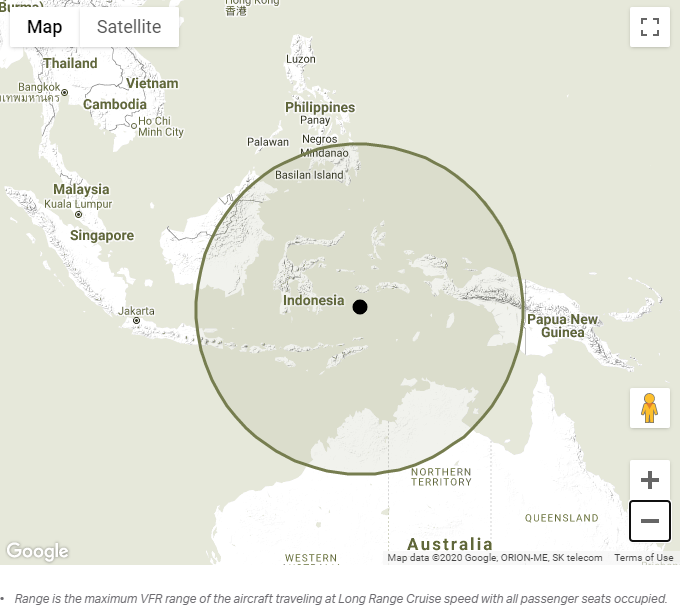
The Osprey coming to the Pacific over the past decade has brought a new capability for HADR operations in the Pacific. And the Marines have demonstrated through the past few years, what this new capability can bring to the challenging conditions which HADR operations entail in the Pacific.
See also, the following:
Editor’s Note: We published this article on January 25, 2013 which looked back at Operation Damayan.
2014-01-25 By Robbin Laird
While many TV commentators seemed to have spent their time covering the Philippine relief situation doing little but to criticize the performance of the Philippine government (Anderson Cooper certainly comes to mind), key contingents of the USMC and USAF were working rapidly to establish the infrastructure for setting in motion the relief effort. And these contingents were working closely with the Philippine forces, and under the authority of the Philippine government.
On the US side, the story is rather a straightforward one: the USMC, the USAF and the USN came rapidly, created infrastructure within chaos to allow for the relief effort to follow and then within two weeks the core insertion force had left.
This is a story of coming to the aide of the Philippines rapidly as only the military can do, and bringing core pieces to the effort which allowed the follow-on forces, in this case relief agencies and personnel to follow.
I have had a chance to interview several of the participants on the US side in the relief effort from the USMC and the USAF and based on their first hand information, a picture emerges of prevailing in very difficult conditions to stand up a relief effort able to start the task of coping with such a significant natural disaster. Two of the persons interviewed had participated in the relief effort in New Orleans after Katrina, and saw distinct parallels.
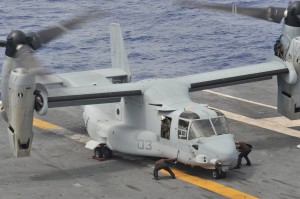
One of these participants was Lt. Col. “Sniper” Brown, the Commanding Officer of the Flying Tigers or VMM-262, which is an Osprey squadron. As Brown described the parallels:
“We knew we would enter a situation of chaos in the ground. We planned for our initial operation and got our planes and personnel ready. That is all that you can do when you don’t know what is about to happen. I had this experience when working on New Orleans relief after Katrina, so I had a sense of how immense the devastation from such an event could look like.”
Brown added: “When I first prepared to land in both situations, what I saw was things I was used to seeing simply gone. That was the baseline from which you worked.”
Another participant was Col. James from PACAF, who was involved in the delivery of aid through the PACAF structure. James is on the operations staff of PACAF and has been working on preparing and executing support for the effort from before the time the Typhoon struck.
His comment on the parallels with New Orleans were as follows:
“I was a reservist and flew in the second commercial plane into New Orleans after the Hurricane hit; in some ways it was just as bad as Typhoon Haiyan. I think it is difficult for someone who has not experienced this to know just how daunting it is to launch a relief effort when everything is simply gone.”
The overall effort was an engagement by the USMC with its integrated air and ground forces to start the relief effort.
Ospreys working closely with their KC-130J tankers were inserted from the outset and shaped the initial support effort. Shortly thereafter, the unique USAF 36th Contingency Response Wing arrived on their C-130s at Tacloban airfield to shape a forward operating base to support relief efforts close to the key areas of devastation.
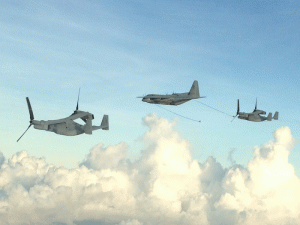
These two forces worked closely together to open up Tacloban as the forward edge of the hub operating from Clark airfield, which functioned as the de facto “Fed Ex” supply base, because Clark had not been damaged by the Typhoon
The USN came with its large deck carrier the USS Washington, which in turn was relieved, by two USN-USMC amphibious ships to continue the operation. Within two weeks of coming, these forces had more or less departed in favor of other key relief elements.
How this came together is the focus of this story.
According to the Commanding Officer of the 36th Crisis Response Group, based in Guam, the Ospreys played a unique role. Col. Livingston noted:
“The Ospreys provided a significant early entry force. The Filipinos loved the way the Ospreys could get into remote locations that had no roads, no infrastructure and could be used to bring assessments teams of civilians and representatives for the Filipino government to what what people in the remote areas needed immediately.”
One might note that only a few months earlier most of the news in the Pacific were protests against the arrival of the Ospreys to Okinawa. Now they are part of the infrastructure for Pacific defense and what the US military calls HA/DR or Human Assistance/Disaster Relief missions.
Indeed, one of the key Osprey squadrons, VMM-262 had only been formed as such at the end of August. Within a very short period of time, the squadron was being tested in very difficult HA/DR conditions.
In an interview with “Sniper” Brown late on Sunday November 17th when he had returned from the day’s activities to Clark Airfield in the Philippines, the CO provided insights into the process and challenges facing the Marines. As it became clear that a Typhoon would hit the Philippines, the Marines began to organize for a possible relief effort. This meant changing gears from preparing for a relaxing holiday weekend (celebrating the USMC birthday through to Veteran’s Day) to ensuring that personnel and planes would be ready for action.
For Brown, it started with working with his next-door neighbor, Lt. Col. “Julio” Julian, the CO of the Sumos, the KC-130J squadron (VMGR-152) stationed at Marine Corps Air Station Futenma, in Okinawa, Japan.
It meant getting the maximum number of Ospreys in his squadron ready for action. Two of his 12 planes were in heavy maintenance cycle, and they needed a 4-ship group for the initial operation. They had 5 ready when first contemplating a response (ready for tasking); the other five were in process of being prepared for operations. The maintainers worked hard to get additional planes ready, which meant that two 4-ship groups would be ready for the initial engagement. The plan was to have the planes ready for operation by the 10th the day of the USMC birthday ball.
“When we realized that the storm was going to be as strong as it was, we knew we needed to have the 10 planes ready to go out of town. Over just two shifts of maintenance we had 10 birds ready to go. We then waited for the official launch order, but we were ready to go.”
They needed to shape an initial engagement plan as well.
When the call to fly into the devastated areas came on Veteran’s Day weekend, the challenge was to put together the ability to fly. “We flew with the Sumos who kept us fueled and carried our logistical needs as well. But we needed to sort out where to go and what the priorities would be in the initial 72 hours.”
According to Brown, the first mission was go to Villamor Airbase, the home of the Philippine Air Force. They went there because it has significant storage of supplies as well as a command post. “We dropped off a couple of liaison officers as well on day one. We did not know what to expect, or where to go day one.”
When they faced day two they did not know what to expect.
“But we were up and running and flying by 0830 on a four ship on day two. We went to Villamour to pick up supplies and then had to determine where to take those supplies.”
Brown highlighted that the disruption of the networks was significant as well, which meant that the satellites and other communications and support systems were in scarce evidence. Anticipating a lack of normal support on the ground such as even electricity, the CO had his Ops team put together a flight schedule for a weeks worth of operations. When the “hold tight” became the go order they were ready when they landed to immediately fly to the people suffering.
“Major “Papi” Guzman who is my assistant operations officer and with whom I flew lead and wing together interchangeably for the first three days and I looked at a story in the Philippine Inquirer newspaper and said lets go to where they said a town was destroyed. We operated with visual reconnaissance to determine where to go and when. At one point we read the local paper to determine which Island needed us most. We decided to fly to Guian peninsula, and when over Guian decided to land on what looked like a soccer field. But it turned out to be a school, with hundreds of children on the field.”
So what happened when they landed in the schoolyard?
“The first thing were a met with is hundreds of kids. I looked at this and thought of my own children. What if these were our kids? Our crew chief started offloading supplies; the kids are waving at us and smiling to us. The local police walked out and then the crowd organized itself into a nice orderly line, even though they have not had food or water for 3 or 4 days. It was amazing to behold. We were blown away by it for we were expecting a press of bodies from the crowd; but they were lined up and waiting for their turn. Amazing.”
In a situation of ground chaos, sorting out the priorities for taking supplies to target points is a key challenge.
“Captain Casey Nelson and his crew did an emergency medevac of a 16 day old baby girl who was dying. They flew here to Manila for emergency treatment and she survived. The co- pilot was a young pilot with 30 hours of flying experience in the squadron. They had to fly alone and over water even though not an experienced crew.
We are a young squadron and our maintainers and support personnel are incredibly dedicated to the round the clock job which we face.”

I did an interview with Guzman as well which filled out the picture of those first few days of disaster relief. According to the Major when they began to touch base in what they thought was a soccer field:
“The area was completely devastated and all we saw was rubble. It was a never-ending path of destruction. My eyes scanned with total amazement. I would see images of families and little kids running around in the streets as we passed over. At first, the area looked deserted. But after we landed hundreds of children and older people came out from under the rubble or from cardboard boxes to approach the plane.
You really do not imagine that many people in such a devastated area, coming out from the woodwork. And older gentlemen came up to the plane and shunted the children away from the plane so we could safely shut it down. If we had not had the newspaper we would not have had a good idea where to start the relief area. ”
I asked him how the first time flyers on the Osprey responded to the experience in such conditions. “Like most first time flyers, they were amazed when we transition from rotor to propeller mode and become a plane. The crew chiefs noted that eyes open wide open when the acceleration takes place and smiles came on the passengers faces. Normally we hold 24 in the back; here we had more than that. I remember we put a man with babies on both shoulders into a jump seat.”
The Major also emphasized the challenge of flying in these conditions. “Normally we do 3 hours of flight planning for each hour of flight; needless to say we were doing 0 hours of flight planning in these conditions on a contingency task.”
As the Marines established some support structure on the ground, they were able to establish Forward Air Refueling Points (FARPs), which could refuel various flying assets, Ospreys and helos being the key focus. When the USS George Washington showed up, those FARPs were established so that the Navy helos operated forward and were refueled by the Marine Corps FARPS. The Ospreys began to land on the carrier as part of its refueling runs. There have been tests of Ospreys landing on large deck carriers, but not in a situation like this one. It was a case of innovation on the fly, quite literally.
The picture of the first few days can only be completed if one includes a largely ignored USAF asset. The USAF has two Crisis Response Groups, one based in New Jersey and the other in Guam. I spent two days in 2011 with the one in New Jersey, and learned that this 120 person unit is organized around modules to provide support to HA/DR or combat missions in conditions of disruption. They have security units, mobile communication unites, airfield repair units, and mobile landing capabilities to handle the need to support incoming lift assets.
All of this was tested in Operation Damayan.
As Colonel Livingston identified in an interview on December 5, 2013:
“A few days prior to the storm hitting the Philippines, we provided a scalable capability input to support any effort. Then when the storm hit, we were tasked to provide an on site assessment of Tacloban airfield.
We were tasked to determine what damage to the infrastructure had occurred, primarily in terms of air traffic control capability, the surface and subsurface of the runway, the stress of the map and the security challenges. Would the airfield be able to support a C-17 or simply C-130s?
We first sent the assessment team in to determine answers to these questions. And the team traveled in on a C-130s initially.
We had a planners operating in Manila on the 10th, we did the airfield assessments on the 14th and the team moved into the airfields on the 15th.
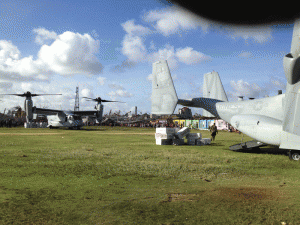
A major challenge from the outset was security. We sent a security team, which worked with the Philippine police to provide for crowd control and management so that we could get the airfield operational.
Conditions were difficult. Our standard package to go out the door is between 90 and 120 people. Originally, we hoped to put 100 into Tacloban but quickly discovered that we had enough dry ground only to have a 50 person team there, and the rest of the team went to Clark.”
It was clear that working under these conditions must be stressful for the airmen involved in the effort and the Colonel responded to a question about the stress and the compressed time line under which they had to work.
“Everyone on the ground was working continuously and under extreme pressure to get the supplies flowing into the area. Within 12 hours, the team was able to open the runway for C-17s, and given the condition of the airfield and the swirl of humanity which had to be brought under control, this was not a given.
It was hair on fire for 96 hours until we could establish a way to set up a steady operational flow.
And there were continual challenges. For example, many of the coalition aircraft arrived without rollers in the back of their C-130s so we could not unload and offload pallets.
This meant that everyone would have to pitch in and move cargo by hand.”
The approach here is as well to shape more capability with allies to augment similar HA/DR capabilities as well.
According to the Colonel:
“One outcome of the relief effort is expanded interest by the Philippine forces in building CRG like capabilities, something we would work with them on if they wished.”
Of course, given the US past in the Philippines there was a certain irony in the US playing a lead role in shaping the initial infrastructure.
When asked about this bit of irony, the Colonel told this story.
“It is ironic as you say. A key requirement was getting drinking water to those affected by the storm. The equipment necessary to do this was brought in by C-17s. We offloaded the water purification units and moved them into Tacloban city.
These all terrain forklifts, which we brought into the airfield, were driving through three or four feet of mud. And we put the kits down right there by MacArthur Landing Memorial Park where he did his landing.
So now the water purification units pumping 20,000 gallons of water to the locals was laid down at an historical point in the US-Philippine history.”
The featured photo: The Ospreys have landed at a school field to provide aid to the survivors of the Typhoon in 2013. Credit: Lt. Col. Brown
The interviews can be found as follows:
Lt. Col. Brown
http://sldinfo.com/we-are-ready-now-sir-the-21st-century-version/
Major Guzman
http://sldinfo.com/the-first-few-days-meeting-the-challenge-of-getting-started-on-philippine-relief/
Col. James
Col. Livingston

